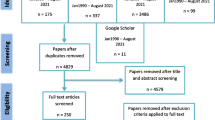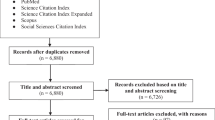Abstract
This paper describes the findings of a literature review conducted on the current usage, lessons, and limitations of e-learning for undergraduate medical education with an emphasis on synchronous delivery in the first 2 years. The review was conducted as part of an initiative to expand the UBC undergraduate medical program in British Columbia, Canada. The 50 e-learning articles included in the review described the deployment of various types of e-learning technology and content in different settings. The seven videoconferencing articles provided product information, health education examples, and innovative approaches. The six review articles provided general guidelines and trends on e-learning in undergraduate medical education in United States and Europe. Overall, while the literature is informative, there are few reported studies that address distributed synchronous learning in these undergraduate programs.
Similar content being viewed by others
REFERENCES
Mames, T. B., Rourke, J., and Strasser, R., Education for rural practice in Canada and Australia. Acad. Med. 71:464, 1996.
Rourke, J., Newbery, P., and Topps, D., Training an adequate number of rural family physicians. Can. Fam. Physician 46:1246–1248, 1252–1255, 2000.
Brooks, R. G., Walsh, M., Mardon, R. E., Lewis, M., and Clawson, A., The roles of nature and nurture in the recruitment and retention of primary care physicians in rural areas: A review of the literature. Acad. Med. 77:790–798, 2002.
Rosenblatt, R. A., Whitcomb, M. E., and Cullen, T. J., Which medical schools produce rural physicians? JAMA 268(12):1559–1565, 1992.
Inoue, K., Hirayama, Y., and Igarashi, M., A medical school for rural areas. Med. Educ. 31(6):430–434, 1997.
Magnus, J. H., and Tollan, A., Rural doctor recruitment: Does medical education in rural districts recruit doctors to rural areas? Med. Educ. 27(3):250–253, 1993.
Fryer, G. E., Geographic benefit from decentralized medical education: Student and preceptor practice patterns.” J. Rural Health 10(3):193–198, 1994.
Ramsey, P. G., Coombs, J. B., Hunt, D. D., Marshall, S. G., and Wenrich, M. D., From concept to culture: The WWAMI Program at the University of Washington School of Medicine. Acad. Med. 76:765–775, 2001.
Author information
Authors and Affiliations
Corresponding author
Rights and permissions
About this article
Cite this article
Lau, F., Bates, J. A Review of e-Learning Practices for Undergraduate Medical Education. Journal of Medical Systems 28, 71–87 (2004). https://doi.org/10.1023/B:JOMS.0000021522.30587.ff
Issue Date:
DOI: https://doi.org/10.1023/B:JOMS.0000021522.30587.ff




